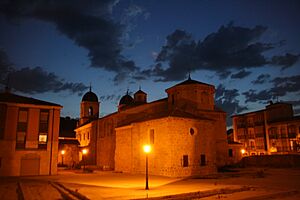Blanche of Portugal (1259–1321) facts for kids
Quick facts for kids Blanche of Portugal |
|
|---|---|
| Lady of Las Huelgas, Montemor-o-Velho, Alcocer and Briviesca | |

Infanta Blanche of Portugal, in António de Holanda's Genealogy of the Royal Houses of Spain and Portugal (1534)
|
|
| Born | 25 February 1259 Santarem, Kingdom of Portugal |
| Died | 17 April 1321 (aged 62) Burgos, Crown of Castile |
| Burial | Abbey of Santa María la Real de Las Huelgas |
| Issue | Juan Núñez de Prado |
| House | Portuguese House of Burgundy |
| Father | Afonso III |
| Mother | Beatrice of Castile |
Blanche of Portugal (born February 25, 1259, in Santarém, Portugal – died April 17, 1321, in Burgos, Spain) was a Portuguese princess, known as an infanta. She was the first child of King Afonso III of Portugal and his second wife, Beatrice of Castile. Blanche was named after her great-aunt, Blanche of Castile, who was the queen of France. She held important titles, including Lady of Las Huelgas, Montemor-o-Velho, Alcocer, and Briviesca, a city she helped to establish.
Contents
Her Life Story
Blanche was born in Santarém. When she was only two years old, her father, King Afonso III, gave her the city of Montemor-o-Velho. This gift was permanent, but it had a special rule: if Blanche died or married someone from outside Portugal, the city would return to the crown.
Following the example of other royal women in her family, like her great-aunt Queen Theresa of Portugal, Queen of León, Blanche went to live at the Monastery of Lorvão in 1277. She was not a nun at this time and never became the head of this religious place.
In 1282, Blanche traveled to Castile with her mother, Queen Beatrice. This happened because her mother had disagreements with Blanche's brother, King Denis of Portugal. At the same time, there was a conflict between her grandfather, King Alfonso X of Castile, and his son, Prince Sancho. Records show that in 1283, Blanche and her mother were living in Seville with King Alfonso X. In his will, the king mentioned his granddaughter Blanche and left her a large amount of money for her marriage.
In 1295, Blanche decided to become a nun at the Convent of Las Huelgas. A letter from April 15, 1295, explains why she joined. Her uncle, King Sancho IV of Castile, advised her to become a nun, even though she was not sure about it at first.

When she joined the convent, Blanche brought her dowry, which included several villages and properties. In 1303, she gave the convent the salt mines from Poza de la Sal and Añana. Blanche was known as the "lady and keeper" of the convent. However, she was never its abbess, which is the head nun. During her time there, from 1296 to 1326, the convent was led by Abbess Urraca Alfonso.
In 1303, after her mother passed away, Blanche inherited the señorío (a type of lordship or estate) of Alcocer. On September 27, 1305, she bought land in the city of Briviesca for 170,000 maravedíes. She is considered the founder of Briviesca because she helped plan and organize the new city. She also helped establish the Colegiata de Santa María, a large church. Blanche did more than just plan the city's streets. She also gave it a legal document called the Fuero in 1313. This document helped govern and manage the city.
Her Final Years
Blanche wrote her will on April 15, 1321. In it, she asked to be buried at the Convent of Las Huelgas. She also requested that ten thousand masses be said for her soul. In her will, she gave the city of Briviesca to King Alfonso XI of Castile. She had a condition: the city should never become a señorío (a private lordship). She also asked the king to pay her debts, which totaled 300,000 maravedíes. She trusted him to protect the city and the Colegiata de Santa María la Mayor, which she had founded. Blanche named several people to carry out her will, including Queen María de Molina and Gonzalo de Hinojosa, who was the bishop of Burgos.
Infanta Blanche died at the Convent on April 17, 1321. Her tomb is decorated with intertwined stars. It also shows the symbols of the kingdoms of Castile, León, and the Kingdom of Portugal.
Her Son
Blanche had a son named Juan Núñez de Prado. He became the Master of the Order of Calatrava. He was a loyal follower of King Alfonso XI of Castile and later his son, King Pedro of Castile. Sadly, King Pedro had Juan Núñez de Prado killed in 1355 at the castle in Maqueda.
See also
 In Spanish: Blanca de Portugal (1259-1321) para niños
In Spanish: Blanca de Portugal (1259-1321) para niños



